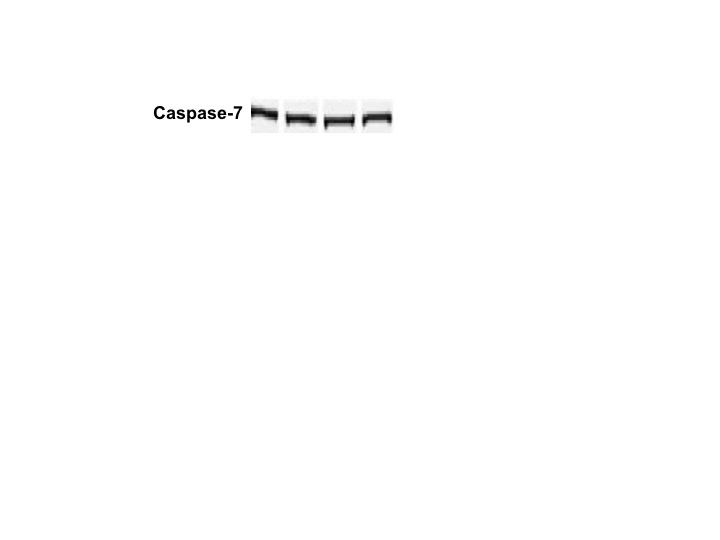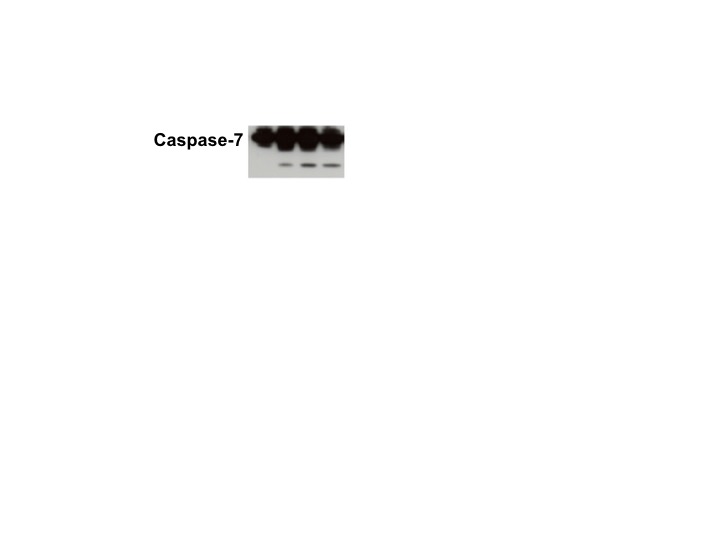Human/Mouse Caspase-7 Antibody Summary
*Small pack size (-SP) is supplied either lyophilized or as a 0.2 µm filtered solution in PBS.
Applications
Please Note: Optimal dilutions should be determined by each laboratory for each application. General Protocols are available in the Technical Information section on our website.
Scientific Data
 View Larger
View Larger
Detection of Human and Mouse Caspase‑7 Precursor and Small Subunit by Western Blot. Western blot shows lysates of Jurkat human acute T cell leukemia cell line untreated (-) or treated (+) with 1 µM staurosporine (STS) for for the indicated times and NIH-3T3 mouse embryonic fibroblast cell line. PVDF membrane was probed with 1 µg/mL of Rabbit Anti- Human/Mouse Caspase-7 Polyclonal Antibody (Catalog # AF823), followed by HRP-conjugated Anti-Rabbit IgG Secondary Antibody (Catalog # HAF008). Specific bands were detected for Caspase-7 precursor and small subunit at approximately 32 and 7 kDa (as indicated). This experiment was conducted under reducing conditions and using Immunoblot Buffer Group 4.
 View Larger
View Larger
Western Blot Shows Human Caspase‑7 Specificity by Using Knockout Cell Line. Western blot shows lysates of A549 human lung carcinoma parental cell line and Caspase-7 knockout A549 cell line (KO). PVDF membrane was probed with 1 µg/mL of Rabbit Anti-Human/Mouse Caspase-7 Antigen Affinity-purified Polyclonal Antibody (Catalog # AF823) followed by HRP-conjugated Anti-Rabbit IgG Secondary Antibody (Catalog # HAF008). A specific band was detected for Caspase-7 at approximately 32 kDa (as indicated) in the parental A549 cell line, but is not detectable in knockout A549 cell line. GAPDH (Catalog # AF5718) is shown as a loading control. This experiment was conducted under reducing conditions and using Immunoblot Buffer Group 1.
Reconstitution Calculator
Preparation and Storage
Background: Caspase-7
Caspase-7 (Cysteine-aspartic acid protease 7/Casp7; also CMH-1, ICE-LAP3 and Mch3) is a 32 kDa member of the peptidase C14A/IL-1 beta -converting family of enzymes (1, 2, 3). It is widely expressed, except in brain, and is best known as an integral component of the apoptotic cascade. Caspase-7 is considered to be an executioner caspase, as a downstream mediator of apoptotic-associated proteolysis (2, 3). Upon activation, Caspase-7 is known to utilize a Cys residue to cleave multiple substrates, including PARP, procaspase 6, Gas2 and calpstatin (1). Human procaspase-7 is a 34‑36 kDa, 303 amino acid (aa) protein (4, 5, 6). Normally, it is an inactive homodimer (1, 2, 7, 8). But following an upstream signal that activates processing proteases, procaspase-7 undergoes proteolytic cleavage to generate an N-terminal 23 aa propeptide, a 175 aa p20/20 kDa subunit (aa 24‑198), and a 105 aa C-terminal p12/12 kDa subunit (5). The p20 and p12 subunits noncovalently heterodimerize, and subsequently associate with another p20/p12 heterodimer to form an active antiparallel homodimer. Additional processing of p20 may remove aa 24‑36 to generate p18, while additional processing of p12 will remove aa 199‑206 to generate p11 (9, 10). Multiple proteases can use Caspase-7 as a substrate, and include caspase-1, -3, -8, and -10, granzyme B, calpain-1 and Caspase-7 itself (3, 6, 9, 11). Caspase-7 is found in both cytosol and nucleus, and possesses a potential KKKK nuclear localization signal between aa 38‑41 that likely undergoes sumoylation (9, 12). There are two potential isoform variants, one which shows an alternate start site 33 aa upstream of the standard start site, and a second that shows a 105 aa substitution for aa 149‑303. Human and mouse Caspase-7 are 82% aa identical at the amino acid level.
- Chowdhury, I. et al. (2008) Comp. Biochem. Physiol. B 151:10.
- Boatright, K.M. and G.S. Salvesen (2003) Curr. Opin. Cell Biol. 15:725.
- Launay, S. et al. (2005) Oncogene 24:5137.
- Juan, T. et al. (1997) Genomics 40:86.
- Fernandez-Alnemri, T. et al. (1995) Cancer Res. 55:6045.
- Fernandez-Alnemri, T. et al. (1996) Proc. Natl. Acad. Sci. USA 93:7464.
- Gao, Z. et al. (2007) J. Biol. Chem. 282:30718.
- Riedl, S.J. et al. (2001) Proc. Natl. Acad. Sci. USA 98:14790.
- Gafni, J. et al. (2009) J. Biol. Chem. July 21 [epub ahead of print].
- Lippke, J.A. et al. (1996) J. Biol. Chem. 271:1825.
- Lamkanfi, M. et al. (2008) Mol. Cell. Proteomics 7:2350.
- Hayashi, N. et al. (2006) Neurosci. Lett. 397:5.
Product Datasheets
Citation for Human/Mouse Caspase-7 Antibody
R&D Systems personnel manually curate a database that contains references using R&D Systems products. The data collected includes not only links to publications in PubMed, but also provides information about sample types, species, and experimental conditions.
1 Citation: Showing 1 - 1
-
The B30.2 domain of pyrin, the familial Mediterranean fever protein, interacts directly with caspase-1 to modulate IL-1beta production.
Authors: Chae JJ, Wood G, Masters SL, Richard K, Park G, Smith BJ, Kastner DL
Proc. Natl. Acad. Sci. U.S.A., 2006-06-19;103(26):9982-7.
Species: Human
Sample Types: Cell Lysates
Applications: Western Blot
FAQs
No product specific FAQs exist for this product, however you may
View all Antibody FAQsReviews for Human/Mouse Caspase-7 Antibody
Average Rating: 4.5 (Based on 2 Reviews)
Have you used Human/Mouse Caspase-7 Antibody?
Submit a review and receive an Amazon gift card.
$25/€18/£15/$25CAN/¥75 Yuan/¥1250 Yen for a review with an image
$10/€7/£6/$10 CAD/¥70 Yuan/¥1110 Yen for a review without an image
Filter by:




